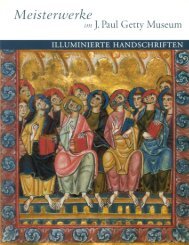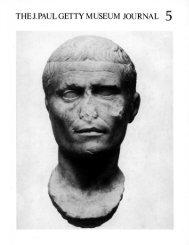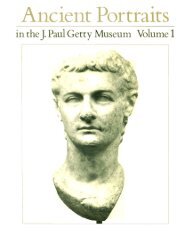The J. Paul Getty Museum Journal Volume 15 1987
The J. Paul Getty Museum Journal Volume 15 1987
The J. Paul Getty Museum Journal Volume 15 1987
Create successful ePaper yourself
Turn your PDF publications into a flip-book with our unique Google optimized e-Paper software.
6 SpierFigures la-c. Left, Pendant set with Graeco-Persian gem. Byzantine, circa sixth century. Gold set with earlier chalcedony scaraboid.Center, back. Right, back. Drawing by Martha Breen Bredemeyer. Malibu, <strong>The</strong> J. <strong>Paul</strong> <strong>Getty</strong> <strong>Museum</strong> 81.AN.76.101.8. Gold pendant found with jewelry and gold coins ofConstans II, Constantine IV, and Tiberius III (fig.8). H: 2.6 cm (1"). Found in Pantalica, Sicily; presentlocation unknown. P. Orsi, Sicilia bizantina(Rome, 1942), vol. 1, no. 7, p. 138, pi. 9.9. Gold disc with engraved cross, perhaps from a pendant(fig. 9). H: 2.1 cm ( 7 /s"). Washington, D.C.,Dumbarton Oaks Research Library and Collection53.12.51. Said to have been found in Constantinople.Ross, D.O. Cat., vol. 2, no. 35, p. 33.10. Silver reliquary pendant with glass cover, relics inside,found with a hoard of gold jewelry. H: 3 cm(l 3 /i6"). Milan, Civico Museo Archeologico. Foundin the excavations at Caesarea Maritima, Israel,1962. Antonio Frova, Scavi di Caesarea Maritima(Milan, 1965), pp. 236-238, figs. 295-297.<strong>The</strong> <strong>Getty</strong> pendant (figs, la—c) is composed of a circularpiece of sheet gold, slightly convex on the back,with the edges folded over the gem on the front side.<strong>The</strong> back is decorated with an engraved circle; withinthis is a pattern of four acanthus leaves arranged so thatthe central unengraved space forms the shape of a cross.Outside the engraved circle is a border of punched dots.A thin, beaded wire is attached along the entire circumferenceof the pendant, and a ridged strip of gold isfolded to form a loop for suspension. <strong>The</strong> gem is achalcedony scaraboid engraved with a running horse,and as noted above, it belongs to a Graeco-Persianworkshop of the late fourth century B.C. Few Byzantineintaglios appear to have been made, and the reuse ofearlier gems in the Byzantine period was not an unusualpractice. Large Graeco-Persian gems were probablyfound frequently, as they are today, and may have beenthought to have magical properties. 5Closest in style to the <strong>Getty</strong> pendant is a fine examplein New York (No. 2, figs. 2a—b) on a gold loop-in-loopchain with round openwork terminals typical of sixthcenturyByzantine work. <strong>The</strong> engraving and patterningare very similar to the <strong>Getty</strong> example, although somewhatmore careful, and the border of punched dots isthe same. A beaded wire is also added to the edge, but itis somewhat thicker than that on the <strong>Getty</strong> pendant.Whatever was set in the pendant is now missing.Another pendant in New York (No. 3; fig. 3) issmaller than No. 2 but is similarly constructed. <strong>The</strong>shape of the engraved cross is slightly different,however, and the common Byzantine cruciform inscriptionc()cbs/£oi)f| (light/life) is added on the cross; this isthe only example among the pendants presently underconsideration to have an inscription. <strong>The</strong> other side ofNo. 3 is undecorated. <strong>The</strong> chain is composed of sixshort loop-in-loop chains joined together with hookson which gems were set; only three of these—an emeraldand two amethysts—survive. <strong>The</strong> gold terminals areheart shaped with filigree openwork. A very similarchain with identical terminals was found with a sixthcenturyByzantine treasure now in Dumbarton Oaks. 6A pendant (No. 4; figs. 4a—b), which was supposedlyfound in Sicily with two gold belt buckles and is now in5. An unpublished Graeco-Persian chalcedony scaraboid in Malibu(85.AN.444.1) was reengraved with magical inscriptions in thethird or fourth century A.D., and another Graeco-Persian scaraboid inOxford bears Koranic texts in Kufic script, which were added in theseventh or eighth century A.D.: See J. Boardman and M.—L. Vollenweider,Catalogue of the Engraved Gems and Finger Rings in the Ashmolean<strong>Museum</strong> (Oxford, 1978), vol. 1, no. 178, and a photo of the backin P. Zazoff, Die antiken Gemmen (Munich, 1983), p. 4, pi. 41.








